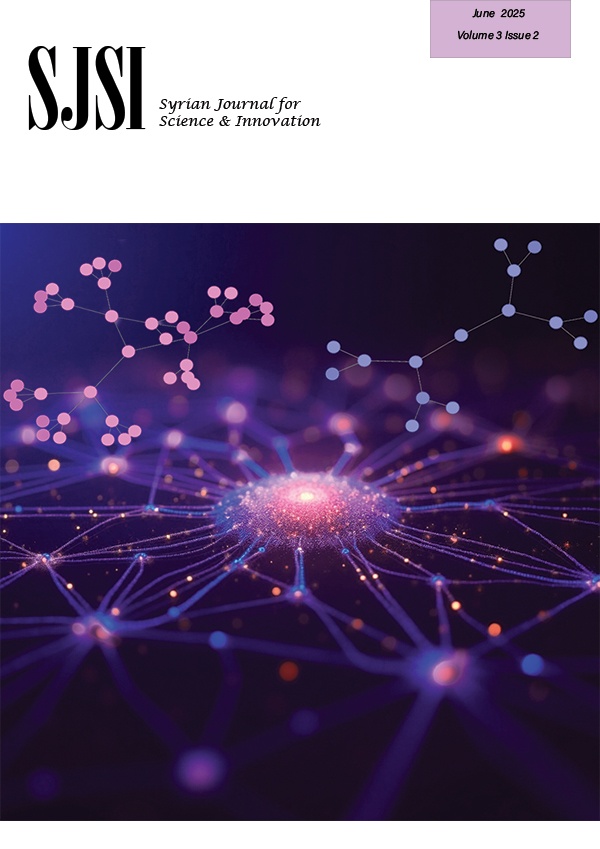Preparation of Nanosilica and Nanosilicone from Glass Wastes [Arabic]
2023-11-27 | Volume 1 Issue 3 - Volume 1 | Research Articles | Abdulrazzaq HammalAbstract
In this research, both silica and silicon were prepared in nanoscale using glass waste, given the wide range of industrial applications covered by these materials especially in the field of electronics and clean energy generation systems. Preparation process included several sequential stages that began with collecting samples of crushed glass and treating them physically (grinding, granular sorting), mixing granulated crushed glass with NaOH in a ratio (1:1) (1:2) (1:3), then treatment in a laboratory furnace at different temperatures (800-900-1000)°C. The next step was treating the sample with diluted HCl 1:1 with heating to 60°C to isolate the silica, which was treated at 900°C for 30 min to form SiO2 nanoparticles with a yield of 68%, and a purity of up to 99.5%. The resulting silica (SiO2) was characterized by XRD and AFM techniques. Results of the two – and three-dimensional images captured by AFM showed the formation of silica nanotubes, and the surface roughness was Ra = 78 nm. Silicon nanoparticles were prepared from silica by mixing it with magnesium powder in a ratio of (SiO2:Mg) (1:2), which was treated at different temperatures (700-750-800-900)°C for two hours, followed by treatment with diluted HCl. It was finally treated with 5% HF to get rid of the associated secondary compounds and obtain silicon with a yield of 90% upon treatment at 800 °C, consistent with previous studies, as the treatment to a higher temperature causes an increase in the byproduct. The analysis by XRD and AFM techniques proved that silicon nano-structure was formed, where surface roughness was Ra = 286 nm. Compared to previous studies, our research presented a promising; low-cost, high-yield method using an industrial waste of glass. The purity of the obtained compounds is comparable to those prepared by other techniques, which are more expensive and difficult.
Keywords : Nano-Silica– Magnesiothermic Reduction-Glass Waste.
References :
- Juenger MCG, Ostertag CP. Alkali–silica reactivity of large silica fume-derived particles. Cement and Concrete Research. 2004 Aug;34(8):1389–402.
- Mammeri, F., Rozes, L., Sanchez, C. et al. Mechanical Properties of SiO2-PMMA Based Hybrid Organic-Inorganic Thin Films. Journal of Sol-Gel Science and Technology 26, 413–417 (2003). https://doi.org/10.1023/A:1020789602816.
- Luo Z, Cai X, Hong RY, Wang LS, Feng WG. Preparation of silica nanoparticles using silicon tetrachloride for reinforcement of PU. Chemical Engineering Journal. 2012 Apr;187:357–66..
- Oki Muraza, Rebrov EV, Tetyana Khimyak, Brian, Kooyman PJ, Lafont U, et al. Mesoporous silica films as catalyst support for microstructured reactors: Preparation and characterization. Chemical Engineering Journal. 2008 Jan 15;135:S99–103.
- Yang X, Huang C, Fu Z, Song H, Liao S, Su Y, et al. An effective Pd-promoted gold catalyst supported on mesoporous silica particles for the oxidation of benzyl alcohol. Applied Catalysis B: Environmental. 2013 Aug;140-141:419–25..
- Al-Azzawi OM, Hofmann CM, Baker GA, Baker SN. Nanosilica-supported polyethoxyamines as low-cost, reversible carbon dioxide sorbents. Journal of Colloid and Interface Science. 2012 Nov;385(1):154–9.
- Zhang H, Zhao X, Ding X, Lei H, Chen X, An D, et al. A study on the consecutive preparation of d-xylose and pure superfine silica from rice husk. Bioresource Technology. 2010 Feb;101(4):1263–7.
- Gielen D, Boshell F, Saygin D, Bazilian MD, Wagner N, Gorini R. The role of renewable energy in the global energy transformation. Energy Strategy Reviews [Internet]. 2019;24(24):38–50. Available from: https://www.sciencedirect.com/science/article/pii/S2211467X19300082
- Kumar M. Social, Economic, and Environmental Impacts of Renewable Energy Resources. Wind Solar Hybrid Renewable Energy System [Internet]. 2020 Jan 21.
- Shahsavari A, Akbari M. Potential of solar energy in developing countries for reducing energy-related emissions. Renewable and Sustainable Energy Reviews. 2018 Jul;90(90):275–91.
- Yan F, Jiang J, Chen X, Tian S, Li K. Synthesis and Characterization of Silica Nanoparticles Preparing by Low-Temperature Vapor-Phase Hydrolysis of SiCl4. Industrial & Engineering Chemistry Research. 2014 Jul 17;53(30):11884–90.
- Al-Abboodi SMThahab, Al-Shaibani EJA, Alrubai EnassA. Preparation and Characterization of Nano silica Prepared by Different Precipitation Methods. IOP Conference Series: Materials Science and Engineering. 2020 Dec 10;978:012031.
- Bernardis S. Engineering impurity behavior on the micron-scale in metallurgical-grade silicon production [Doctoral Theses]. [Massachusetts Institute of Technology ]; 2012. P122
- Farirai F, Ozonoh M, Aniokete TC, Eterigho-Ikelegbe O, Mupa M, Zeyi B, et al. Methods of extracting silica and silicon from agricultural waste ashes and application of the produced silicon in solar cells: a mini-review. International Journal of Sustainable Engineering. 2020 Mar 18;14(1):57–78.
- Wiik K. Kinetics of reactions between silica and carbon [Internet]. ntnuopen.ntnu.no. 1990 [cited 2023 Sep 16]. Available from: http://hdl.handle.net/11250/2396774
- Azam Rasouli, M.G. Tsoutsouva, Safarian J, Tranell G. Kinetics of Magnesiothermic Reduction of Natural Quartz. Materials. 2022 Sep 21;15(19):6535–5.
- Zhang Z, Wang J, Liu L, Shen B. Preparation and characterization of glass-ceramics via co-sintering of coal fly ash and oil shale ash-derived amorphous slag. 2019 Nov 1;45(16):20058–65.
- KOVACEC, M.; PILIPOVIC, A.; STEFANIC, N. Impact of glass cullet on the consumption of energy and environment in the production of glass packaging material. Recent Researches in Chemistry, Biology, Environment, and Culture. Monteux, Switzerland, 2011.
- Battaglia, A. Cuevas, S. De Wolf, High-efficiency crystalline silicon solar cells: status and perspectives, Energy Environ. Science. 9 (5) (2016) 1552–1576.
- Karpukhina, R.G. Hill, R.V. Law Crystallisation in oxide glasses – a tutorial review Chem. Soc. Rev., 43 (2014), pp. 2174-2186
- Pei F, Zhu G, Li P, Guo H, Yang P. Effects of CaF2 on the sintering and crystallisation of CaO–MgO–Al2O3–SiO2 glass-ceramics. Ceramics International [Internet]. 2020 Aug 1 [cited 2023 Jun 13];46(11, Part A):17825–35.
(ISSN - Online)
2959-8591

